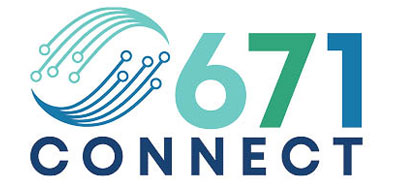We are fully committed to enhancing internet services in Guam. Our strategy is more than a plan; it's a pledge driven by the belief in the transformative power of connectivity. Balancing all islanders' input with data-driven evidence, we approach our mission with unwavering resolve. In the face of challenges, our focus on access, affordability, and quality remains steadfast, without preference. We will not waver in our pursuit of a connected and empowered Guam.
Evidence-Based Decision Making:
Any alteration or shifting in our goals related to access, affordability, speeds, and better internet for Guam must come from rigorous evidence that we should change the course. Our experience teaches us that unchecked data usually leaves Guam behind. If we are to stray from better service efforts for our people, transparency and full disclosure are essential; these changes must undergo rigorous counter-testing to find the truth about Guam’s current internet service.
Community Input:
Decisions around these critical areas must involve robust community input. The people of Guam must have a say in shaping their internet services, and this community perspective will ensure that decisions align with real-world needs and priorities. We will engage directly with residents village by village to hear what they have to say about the true state of their service.
Partnership Instead of Posturing:
From the outset, we've engaged carriers in individual, confidential discussions to ensure that our action plan is as informed as possible. We understand the competitive nature of their businesses and have created spaces for candid feedback. Rest assured, their voices are heard, and their contributions to Guam are respected; an equitable plan also demands that community stakeholders have an equal seat at the table.
This is not a zero-sum game where one party's gain is another's loss. Victory, in this context, is universally improved access to fast, reliable, and affordable internet, regardless of location or income level. The goal is to foster a climate of collaboration and transparency, aligning all stakeholders in a concerted effort to elevate the digital quality of life for the people of Guam.
Seeking More Funding to Support ACP:
Guam has made significant progress in securing funding for high-speed internet adoption through BEAD and Digital Equity, but our efforts don't stop here. OIPD is actively pursuing additional resources to promote the Affordable Connectivity Program (ACP).
Recently, OIPD received notification of an allocation of $383,000 in funding from the FCC to enhance the promotion of the ACP. Despite outreach efforts by internet service providers to reach eligible Guamanians, we have only seen 1,324 ACP subscribers, (as of this writing, June, 2023), which is among the lowest figures in the nation and falling significantly short of the number of eligible residents.
We aim to utilize these funds to ensure that eligible households for this benefit are well-informed about their eligibility through their carriers.
Alignment with Guam's Priorities:
The BEAD strategy must align with Guam's unique selection of priorities, reflecting its specific context and challenges. This alignment ensures the plan is tailored to Guam's situation, making a more effective and community-driven approach to decision-making in these critical areas to ensure that changes are made judiciously and that they truly serve the people of Guam.
Beyond the Fabric:
It is essential to recognize that the national map used for BEAD, known as FCC Fabric, is primarily based on incomplete data and carrier claims of available marketing speeds. This method has proven insufficient, a concern that has been nationally recognized. Looking at the fabric incorrectly can lead to the false conclusion that Guam is 100% ‘served’— which was an assumption that the federal government had deliberated then resoundingly rejected. The accurate picture of 'served and unserved' means the community should be the guiding principle in our decision-making when weighing projects. Despite the Fabric being the FCC's best efforts at the time, existing maps need to be revised, relying on incomplete data and unchecked reported marketing from carriers. The situation on the ground in Guam must take precedence, focusing on the welfare of the people rather than on inaccurate data.
At one point the FCC Fabric presented Guam as 100% served, despite only having 12% of the map complete. While inaccurate, the Fabric had to be our starting point by statute.
This commitment to accuracy has led not only the Governors of the Pacific Territories to contest the FCC Fabric's conclusions officially, but also the Guam carriers who submitted the data in the first place. Some carriers, acknowledging the shortcomings in the fabric, actively contributed to refuting the FCC Fabric's accuracy. Their involvement underscores the importance of ensuring that our understanding of internet accessibility in Guam is grounded in reality and not in unreliable methodologies.
BEAD Fund Priorities:
Guam is considered fully unserved because of latency. As the community has told us, access is only possible with affordability. The NOFO addresses the issues related to affordability under the BEAD program, which needs to be considered a priority. Also, the figures of what some call 'fully served' that are provided, must be critically analyzed considering the FCC's shortcomings in mapping the Pacific territories, including Guam.
Our choice to pursue a data center is based on the consensus of engineers and experts who agree that a linked public-private partnership of other smaller data centers, anchored by a robust Tier 4 Green Data Center is the best limited option. We must give Guam its best shot. FCC Maps used for the analysis do not accurately depict the situation in Guam. Our focus on latency is important but is secondary to the real need for affordable and reliable access to underserved areas. Solutions that serve people rather than just technical milestones should be sought.
In creating U.S. based content delivery networks (CDNs) in Guam to improve latency to U.S. content for Guam's residents, we firmly commit to focusing our efforts on enhancing access to websites and sources that our community visits. Unlike measurements against hosts in non-English speaking countries, our priority is ensuring seamless access to sites used in the U.S. mainland, such as Amazon.com, not for example, Amazon.co.jp or Amazon.cn. Measuring latency to new CDNs with content on U.S. soil, we believe, will best serve our people.
Unserved and Underserved Locations:
Unserved means service under 25 Mbps down, 3 Mbps up, and sub-100ms latency. Another definition of unserved is not getting what you pay for or if you can afford it at all. Recommendations for improving broadband to unserved and underserved locations and addressing Community Anchor Institutions (CAIs) needs are welcome. We intend to take a community-centered approach, prioritizing technical requirements and existing infrastructure. Post-allocation, we will determine our challenge process and our mapped priorities. There is a need to focus on community needs, education, access, and affordability, considering the actual situation in Guam, not merely what is shown in potentially faulty maps.
Consideration of Alternative Eligible Uses
Our focus must be on genuinely assessing community needs and prioritizing latency, speed, and affordable access. Collaborations with local institutions, community involvement, and transparent decision-making must guide the allocation of funds. We also see other projects best handled by concurrent Digital Equity Capacity grants, proposed and transparently procured without business influence.
Hierarchy of Projects
More cooperative approaches that involve community engagement, transparent processes, and prioritizing human welfare over technical and business interests are essential. The primary emphasis must be on the people of Guam, their real needs, and the gaps in service that exist, rather than relying on possibly misleading data and focusing solely on technical aspects. Cooperation, community engagement, and a focus on affordability must be at the forefront of any proposals and actions.
We recognize that everyone in our community is classified as 'unserved.' We intend to change this, and we're willing to explore all means to do so. Whether it's expanding wireless access, building out fiber-to-home connections, understanding the importance of the ‘last mile’ build-outs, or embracing innovative solutions that may arise, we are committed to ensuring that every Guamanian has access.
After a year of discussion with the FCC, we know all too well that bad data and misplaced priorities can take us off track. But by staying focused on affordability, cooperation, and community engagement, we're ensuring that every proposal and every action we take is aligned with what's best for Guam.
In our steadfast pledge to Guam, we focus on genuine community needs, prioritizing access, affordability, and quality of internet service. We are confident that our partners agree. We proceed without preference, guided by evidence and transparency, to ensure that we meet Guam's unique challenges head on.


